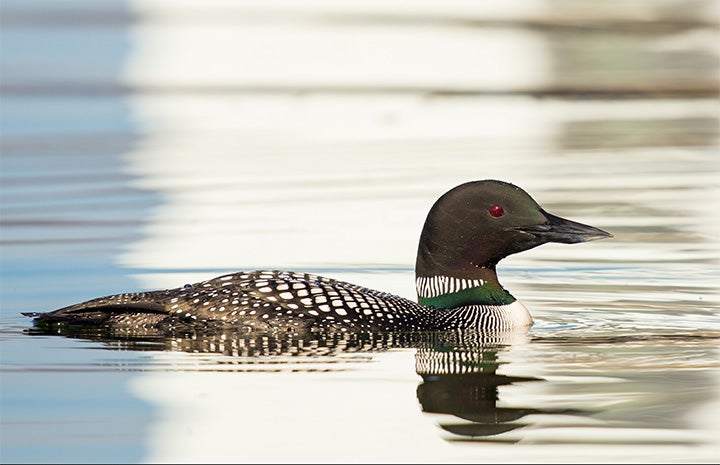SCIENTIFIC NAME:
Gavia immer
OTHER NAMES:
Loon
STATUS:
Common in winter in Tennessee Valley and Gulf Coast regions, but uncommon to rare in Inland Coastal Plain and Mountain regions. Rare to occasional in summer in all regions. Lowest Conservation Concern.
DESCRIPTION:
The common loon (Gavia immer) is a relatively large water bird (28-30 in.) with a heavy body and pointed bill. The head is boldly black with a prominent neck ring and black and white pattern on its back during breeding periods. While wintering in Alabama all upper parts are grey with lower parts white. Common loons sit low in the water while swimming. Commonly mistaken for cormorants, loons are larger in appearance and typically solitary. Considered a true sound of wilderness, its far-carrying laugh or yodel is among the most extraordinary sounds in nature. Although it is a strong flier, this bird can only take off from water. Its legs are set so far back on its body that it is a poor walker, but once in the water it is completely at home.
DISTRIBUTION:
Gavia immer breeds in the northern part of the northern hemisphere from Alaska and Labrador to New England, North Dakota and California. It winters south to Florida and the GulfCoast. Loons can be observed daily along the causeways of LakeGuntersville and from the Tennessee River bridges from late fall until early spring when they migrate north.
HABITAT:
Discreet forested lakes and rivers during breeding; oceans, bays, and large open water inland lakes in winter.
FEEDING HABITS:
Common loons are excellent underwater swimmers and feed primarily on fish, but will occasionally eat shellfish, frogs and aquatic insects. Loons generally are more tolerant of others on winter feeding grounds and will loosely gather in flocks.
LIFE HISTORY AND ECOLOGY:
Common loons are typically monogamous. The female builds a nest up to two feet in diameter made of mud and aquatic vegetation very close to water. The same nest is used annually to lay and hatch two to three olive brown, lightly spotted eggs. Both sexes appear to rear young but are so familiar in appearance it is difficult to tell. Young of the year precede adults in long, fall migrations to the south. Nesting habits by loons in Alabama has not been observed or recorded.
REFERENCES:
Bull, J., John Farrand Jr. 1977. The Audubon Society Field Guide of North American Birds. Alfred A. Knoph, New York, N.Y. 466pp.
Griscom, Ludlow. 1950. Audubon’s Birds of America. The Macmillan Co., New York, N.Y. 33pp.
Wernert, Susan J., Reader’s Digest North American Wildlife. Reader’s Digest Association, Pleasantville, N.Y. 1982.
Bent, Arthur Cleveland. 1919. Life Histories of Familiar North American Birds. United StatesGovernmentPrintingOfficeSmithsonianInstitutionUnited StatesNationalMuseum Bulletin - 107 (47-60).
Author:
Stuart Goldsby, Regional Hunter Education Coordinator, Division of Wildlife and Freshwater Fisheries.







